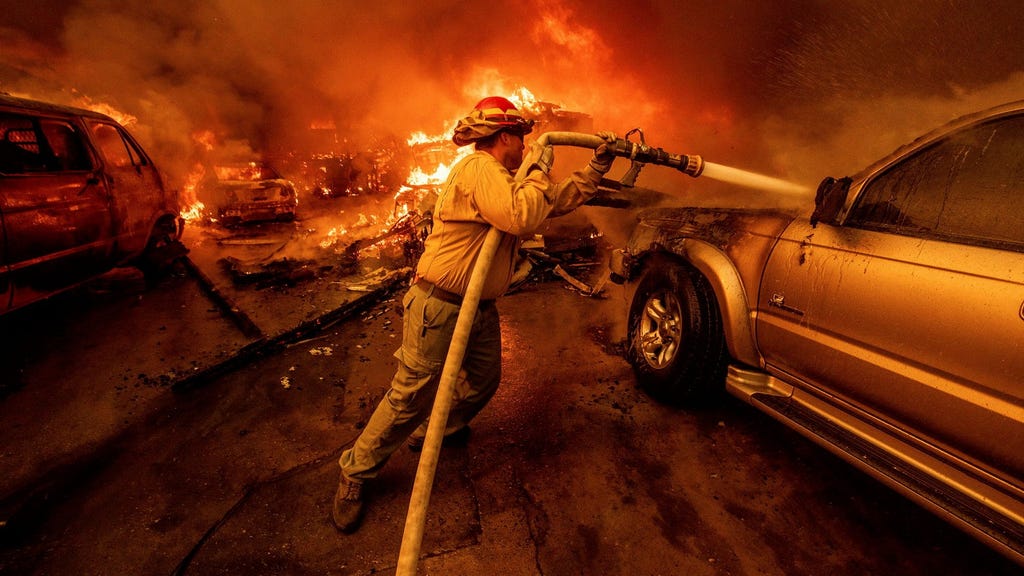The devastating wildfires currently ravaging Los Angeles County, California, have painted a grim picture of destruction and displacement, leaving a trail of charred landscapes and shattered lives in their wake. Driven by fierce Santa Ana winds, historically low humidity levels, and an extended drought, the flames have exploded across vast swathes of land, consuming homes, businesses, and critical infrastructure. The infernos have created an apocalyptic scene, with towering plumes of smoke blotting out the sun, turning day into a hazy, orange twilight. The scale of the disaster is staggering, with thousands of acres reduced to ash and countless residents forced to flee their homes in the face of the rapidly advancing flames. While firefighters battle tirelessly on the front lines, the situation remains volatile and unpredictable, with the potential for further devastation looming large. The current death toll stands at five, a stark reminder of the human cost of this natural disaster, and many more have suffered injuries, ranging from smoke inhalation to severe burns.
The human tragedy unfolding amidst the inferno is heartbreaking. Tens of thousands of residents, forced to evacuate with little more than the clothes on their backs, are now grappling with the uncertainty of their future. Evacuation centers have been established, offering temporary refuge and essential supplies, but the overwhelming number of displaced individuals has stretched resources thin, creating a logistical challenge of immense proportions. Families have been separated, pets lost, and livelihoods destroyed. The emotional toll of losing homes, cherished possessions, and a sense of security is immeasurable. Stories of narrow escapes and harrowing journeys through smoke-filled streets are emerging, showcasing the resilience and bravery of those caught in the fire’s path, yet also underscoring the profound impact of this catastrophe on the human spirit. The road to recovery for these displaced residents will be long and arduous, requiring sustained support and resources to rebuild their lives and communities.
The current wildfires highlight the growing threat of climate change and its role in exacerbating natural disasters. Prolonged periods of drought have created tinderbox conditions across much of California, making the landscape highly susceptible to ignition and rapid fire spread. Rising global temperatures, coupled with shifting weather patterns, contribute to the creation of these extreme fire conditions. The severity and frequency of wildfires in recent years serve as a stark warning of the urgent need to address climate change and implement strategies for mitigating its impact. This includes investing in fire prevention measures, improving forest management practices, and developing more resilient infrastructure to withstand future fire events. The wildfires underscore the interconnectedness of environmental and human systems and the devastating consequences of neglecting our planet’s health.
Beyond the immediate devastation, the long-term consequences of these fires will be far-reaching. The economic impact on businesses, agriculture, and tourism will be substantial, affecting both local communities and the wider regional economy. The destruction of homes and critical infrastructure will require significant investment in rebuilding efforts, a process that could take years. Furthermore, the environmental damage caused by the fires, including air pollution, soil erosion, and habitat loss, will have lasting effects on the ecosystem. The release of greenhouse gases during the burning further contributes to climate change, creating a vicious cycle of destruction. Addressing these long-term challenges will require a coordinated effort from government agencies, non-profit organizations, and community members to ensure a sustainable and resilient recovery.
The heroic efforts of firefighters continue to be a beacon of hope amidst the devastation. Working tirelessly in perilous conditions, these brave men and women are risking their lives to protect communities and contain the spread of the flames. Their dedication and skill are evident in the numerous successful rescues and the countless homes saved from the fire’s grasp. The outpouring of support for firefighters, from local businesses providing meals and supplies to residents offering words of encouragement, demonstrates the deep appreciation for their selfless service. The collaborative efforts between different firefighting agencies, both within California and from neighboring states, highlight the importance of coordinated response in the face of such large-scale disasters. Their unwavering commitment serves as a testament to the human spirit’s ability to rise to challenges even in the darkest of times.
Looking ahead, the focus will shift from immediate emergency response to long-term recovery and rebuilding. The process of assessing the full extent of the damage and developing comprehensive recovery plans will be a complex undertaking, requiring collaboration between various stakeholders. Providing adequate housing, healthcare, and mental health services to displaced residents will be paramount. Rebuilding infrastructure, supporting businesses, and restoring the natural environment will require substantial investment and a long-term commitment. The resilience of the affected communities will be crucial in overcoming the challenges ahead. This disaster underscores the importance of community preparedness, early warning systems, and access to accurate information during emergencies. Learning from this experience and implementing measures to mitigate the impact of future wildfires will be essential to safeguarding lives, property, and the environment.














